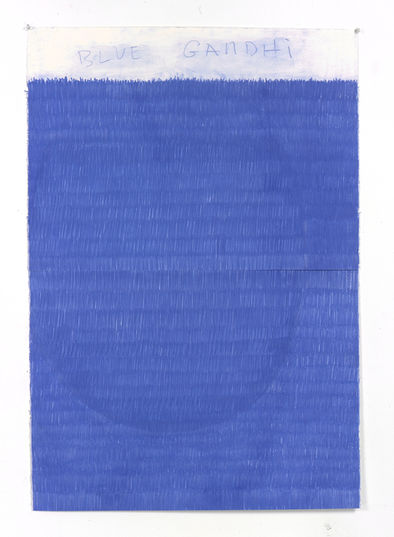GANDHI BLUES
I began this inquiry into Mahatma Gandhi's South African legacy because of his involvement with the sugar cane workers there. During his 21 years in South Africa Gandhi developed his identity as an activist and public figure working with indentured Indian workers. Gandhi did not start out as a bottom-up leader of the underclasses. His views of race, class, and caste published in his newsletter “India Opinion” were conservative and could be considered racist.
Gandhi's overlap into American consciousness goes full circle, beginning with Thoreau's passive resistance ideas that influenced Gandhi's early protest strategies. This impact continued to the American Civil Rights protests, and to any kind of organized resistance movement today.
The drawings are a kind of visual record as I processed my feelings and reached an understanding of the arc of Gandhi’s life and influence. The paper ranges in size from 16 x 20” to 44 x 92”. Starting with gestural works using burnished graphite and text, I later began using blue charcoal, human hair, and collaged South African flags. The blue charcoal has a depth and beauty that creates a linear contemplative field. Hair has a particularly laden presence that launches itself into space and consciousness like few materials. When used traditionally, hair symbolizes and expedites the afterlife journey to the spirit world. I use hair to symbolize the human presence in Gandhi’s South Africa.
From a social-political perspective Gandhi’s history is both problematic and seminal. The American Civil rights movements, Black Lives Matter, the Occupy Movement, Spring, Gezi, or any kind of non-violent civil disobedience used by a populist movement has a residue of Gandhi’s influence. Groups espousing more forceful resistance measures like India’s Naxalite movement, or even Malcolm X, are still responding to Gandhi’s position. The Satyagraha* methods he evolved in South Africa were effective in organizing the Indian people to Independence. He left many examples of self sacrifice to a just cause. He linked self reliance, sustainable living, and public hygiene to social justice movements. Gandhi brought a miracle of unity to India. He literally and figuratively walked the walk, and talked the talk.
* Satyagraha: Sanskrit; Satya: truth; Agraha: soul-force. Truth with Force

© 2024 Michael Pribich sky7@mindspring.com 917-509-0239












